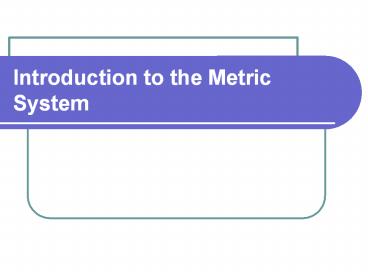Introduction to the Metric System PowerPoint PPT Presentation
Title: Introduction to the Metric System
1
Introduction to the Metric System
2
History
- Created during French Revolution (1790)
- New system of Weights and Measures created
- Called Systeme International dUnitès,
- or SI - International System of Units
- Revised periodically
- by International Bureau of Weight and Measures
3
Customary Units of Measurement
- The English System
- a collection of functionally unrelated units
- Difficult to convert from one unit to another
- Ex. 1 ft 12 inches 0.33 yard 1/5280 miles
- Customary Units
- length - inch, foot, yard, mile
- weight/mass - ounce, pound
- volume - teaspoon, cup, quart, gallon
- temperature - degrees Fahrenheit
- time - minutes, hours
4
Advantages of Using the Metric System
- Universal
- Simple to use
- A few base units make up all measurements
5
Advantages of Using the Metric System
- There is only one unit of measurement for each
type of quantity - To simplify things, very small and very large
numbers are expressed as multiples of the base
unit. - Prefixes are used to represent how much smaller
or larger the quantity is compared to the base
unit. - Easy to convert from one unit to another
- shift decimal point right
- shift decimal point left
6
Advantages of Using the Metric System
- Same set of prefixes for all units
- Greek - multiples of the base
- kilo - 1000 the base
- hecto - 100 the base
- deka - 10 the base
- Latin - fractions of the base
- deci - tenths of the base
- centi - hundredths of the base
- milli - thousandths of the base
- Mnemonic Kids Have Dropped Over Dead Converting
Metrics.
7
Metric Units of Measurement
- Metric Units
- length meter (m)
- weight/mass gram (g)
- volume liter (L)
- temperature - degrees Celsius (C)
- time seconds (s)
8
Measurement Unit Conversion
- You can convert between units of measurement
- within the metric system
- between the English system and metric system
9
Unit Conversion
- Let your units do the work for you by simply
memorizing connections between units. - Example How many donuts are in one dozen?
- We say Twelve donuts in a dozen.
- Or 12 donuts 1 dozen donuts
- What does any number divided by itself equal?
- ONE!
10
Unit Conversion
- This fraction is called a unit factor
- Multiplication by a unit factor does not change
the amount - only the unit. - Example How many donuts are in 3.5 dozen?
- You can probably do this in your head but try it
using the Factor-Label Method.
11
Unit Conversion Rules
- Start with the given information
- Then set up your unit factor
- See that the original unit cancels out
- Then multiply and divide all numbers
12
Unit Conversion Practice
- Example Convert 12 gallons to units of quarts.
13
Unit Conversion Practice
- Example Convert 4 ounces to kilograms.
14
Temperature Conversions
- Conversion Between Fahrenheit, Celsius, and
Kelvin - Example
- Convert 75 ºC to ºF
- Convert -10 ºF to ºC
15
Scientific Notation
16
What is Scientific Notation?
- Scientific notation is a way of expressing really
big numbers or really small numbers in a more
concise form. - It is most often used in scientific
calculations where the analysis must be very
precise.
17
Scientific notation consists of two parts
- A number between 1 and 10
- A power of 10
- N x 10x
- Are the following in scientific notation?
18
To change standard form to scientific notation
- Place the decimal point so that there is one
non-zero digit to the left of the decimal point. - Count the number of decimal places the decimal
point has moved from the original number. This
will be the exponent on the 10.
19
Continued
- If the original number was less than 1, then the
exponent is negative. If the original number was
greater than 1, then the exponent is positive.
20
Example 1
- Given 289,800,000
- Use 2.898 (moved 8 places)
- Answer 2.898 x 108
21
Example 2
- Given 0.000567
- Use 5.67 (moved 4 places)
- Answer 5.67 x 10-4
22
Practice
- Use the link below to practice converting
standard form to scientific notation. - Converting to Scientific Notation
23
To change scientific notation to standard form
- Simply move the decimal point to the right for
positive exponent 10. - Move the decimal point to the left for negative
exponent 10. - (Use zeros to fill in places.)
24
Example 3
- Given 5.093 x 106
- Answer 5,093,000 (moved 6 places to the right)
25
Example 4
- Given 1.976 x 10-4
- Answer 0.0001976 (moved 4 places to the left)
26
Practice
- Use the link below to practice converting
scientific notation to standard form. - Converting to Standard Form
27
Now take the quiz to test your scientific
notation skills!
- Click on the link below to take the quiz and then
use the answer key for the correct answers. - Quiz
- Answers

